- Home
- Terry Pratchett
The Folklore of Discworld
The Folklore of Discworld Read online
THE FOLKLORE OF
DISCWORLD
Legends, myths and customs from the Discworld
with helpful hints from planet Earth
Terry Pratchett
and
Jacqueline Simpson
LONDON • TORONTO • SYDNEY • AUCKLAND • JOHANNESBURG
This eBook is copyright material and must not be copied, reproduced, transferred, distributed, leased, licensed or publicly performed or used in any way except as specifically permitted in writing by the publishers, as allowed under the terms and conditions under which it was purchased or as strictly permitted by applicable copyright law. Any unauthorised distribution or use of this text may be a direct infringement of the author’s and publisher’s rights and those responsible may be liable in law accordingly.
Version 1.0
Epub ISBN 9781407034249
www.randomhouse.co.uk
TRANSWORLD PUBLISHERS
61–63 Uxbridge Road, London W5 5SA
A Random House Group Company
www.rbooks.co.uk
First published in Great Britain
in 2008 by Doubleday
an imprint of Transworld Publishers
Copyright © Terry and Lyn Pratchett and Jacqueline Simpson 2008
Illustrations © Paul Kidby 2008
Terry Pratchett and Jacqueline Simpson have asserted their right under the Copyright, Designs and Patents Act 1988 to be identified as the authors of this work.
Discworld ® is a trademark registered by Terry Pratchett
‘The Ship of Death’ from The Complete poems of D. H. Lawrence reproduced by permission of Pollinger Limited and the Estate of Frieda Lawrence Ravagli. Permission to reprint lines from ‘East Coker II’ in Four Quartets by T. S. Eliot granted by Faber and Faber Ltd.
A CIP catalogue record for this book is available from the British Library.
ISBN 9780385611008
This book is sold subject to the condition that it shall not, by way of trade or otherwise, be lent, resold, hired out, or otherwise circulated without the publisher’s prior consent in any form of binding or cover other than that in which it is published and without a similar condition, including this condition, being imposed on the subsequent purchaser.
Addresses for Random House Group Ltd companies outside the UK can be found at: www.randomhouse.co.uk
The Random House Group Ltd Reg. No. 954009
The Random House Group Limited supports The Forest Stewardship Council (FSC), the leading international forest-certification organization. All our titles that are printed on Greenpeace-approved FSC-certified paper carry the FSC logo. Our paper procurement policy can be found at www.rbooks.co.uk/environment
Typeset in 11/15.5 Sabon by Falcon Oast Graphic Art Ltd. Printed and bound in Great Britain by Clays Ltd, Bungay, Suffolk
2 4 6 8 10 9 7 5 3 ß1
Contents
Cover
Title
Copyright
About the Author
Introduction by Terry Pratchett
Introduction by Jacqueline Simpson
1 The Cosmos: Gods, Demons and Things
2 Dwarfs
3 The Elves
4 The Nac Mac Feegle
5 Trolls
6 Other Significant Races
7 Beasties
8 The Witches of Lancre
9 The Land of Lancre
10 The Witches of the Chalk
11 The Chalk
12 Heroes!
13 Lore, Legends and Truth
14 More Customs, Nautical Lore and Military Matters
15 Kids’ Stuff … You know, about ’Orrid Murder and Blood
16 Death
Bibliography and suggestions for further reading
Index
Also by Terry Pratchett
The Discworld ® series
1. THE COLOUR OF MAGIC
2. THE LIGHT FANTASTIC
3. EQUAL RITES
4. MORT
5. SOURCERY
6. WYRD SISTERS
7. PYRAMIDS
8. GUARDS! GUARDS!
9. ERIC (illustrated by Josh Kirby)
10. MOVING PICTURES
11. REAPER MAN
12. WITCHES ABROAD
13. SMALL GODS
14. LORDS AND LADIES
15. MEN AT ARMS
16. SOUL MUSIC
17. INTERESTING TIMES
18. MASKERADE
19. FEET OF CLAY
20. HOGFATHER
21. JINGO
22. THE LAST CONTINENT
23. CARPE JUGULUM
24. THE FIFTH ELEPHANT
25. THE TRUTH
26. THIEF OF TIME
27. THE LAST HERO (illustrated by Paul Kidby)
28. THE AMAZING MAURICE & HIS EDUCATED RODENTS (for younger readers)
29. NIGHT WATCH
30. THE WEE FREE MEN (for younger readers)
31. MONSTROUS REGIMENT
32. A HAT FULL OF SKY (for younger readers)
33. GOING POSTAL
34. THUD!
35. WINTERSMITH (for younger readers)
36. MAKING MONEY
Other books about Discworld
THE SCIENCE OF DISCWORLD (with Ian Stewart and Jack Cohen)
THE SCIENCE OF DISCWORLD II: THE GLOBE (with Ian Stewart and Jack Cohen)
THE SCIENCE OF DISCWORLD III: DARWIN’S WATCH (with Ian Stewart and Jack Cohen)
THE NEW DISCWORLD COMPANION (with Stephen Briggs)
NANNY OGG’S COOKBOOK (with Stephen Briggs, Tina Hannan and Paul Kidby)
THE PRATCHETT PORTFOLIO (with Paul Kidby)
THE DISCWORLD ALMANAK (with Bernard Pearson)
THE UNSEEN UNIVERSITY CUT-OUT BOOK (with Alan Batley and Bernard Pearson)
WHERE’S MY COW? (illustrated by Melvyn Grant)
THE ART OF DISCWORLD (with Paul Kidby)
THE WIT AND WISDOM OF DISCWORLD (compiled by Stephen Briggs)
Discworld maps
THE STREETS OF ANKH-MORPORK (with Stephen Briggs)
THE DISCWORLD MAPP (with Stephen Briggs)
A TOURIST GUIDE TO LANCRE – A DISCWORLD MAPP (with Stephen Briggs, illustrated by Paul Kidby) DEATH’S DOMAIN (with Paul Kidby)
A complete list of other books based on the Discworld series – illustrated screenplays, graphic novels, comics and plays, can be found on www.terrypratchett.co.uk.
Non-Discworld novels
GOOD OMENS (with Neil Gaiman)
STRATA THE DARK SIDE OF THE SUN THE UNADULTERATED CAT (illustrated by Gray Jolliffe)
Non-Discworld novels for younger readers
THE CARPET PEOPLE
TRUCKERS
DIGGERS
WINGS
ONLY YOU CAN SAVE MANKIND
JOHNNY AND THE DEAD
JOHNNY AND THE BOMB
NATION
THE FOLKLORE OF
DISCWORLD
Visit www.terrypratchett.co.uk for news and information,
to join the forum and to register for updates.
www.rbooks.co.uk
Introduction
by Terry Pratchett
A number of things conspired to cause this book to be written.
There was the time when I was in a car with several other grownup, literate people and we passed a sign to the village of Great Dunmow, in Essex. I said aloud, ‘Oh, yes. Home of the Dunmow Flitch.’ They had not heard of it, yet for centuries a married man could go to that village on a Whit Monday and claim the prize of a flitch (or side) of bacon if he could swear that he and his wife had not quarrelled, even once, during the past year. And that he had never wished he was a bachelor again. Back in the late
fifties and early sixties the Flitch ceremony used to be televised, for heaven’s sake.
Not long after this I did a book-signing on the south coast, when I took the opportunity to ask practically every person in the queue to say the magpie rhyme (I was doing research for Carpe Jugulum). Every single one of them recited, with greater or lesser accuracy, the version of the rhyme that used to herald the beginning of the 1960s and 70s children’s TV programme Magpie – ‘One for sorrow, two for joy’. It wasn’t a bad rhyme, but like some cuckoo in the nest it was forcing out all the other versions that had existed around the country (some of which will appear in a later chapter). Then a distinguished-looking lady was in front of me with a book, and I asked her, with some inexpressible hope in my heart, how many versions of the magpie rhyme she knew. After a moment’s thought, she said ‘about nineteen’.
And that was how I met Jacqueline Simpson, who has been my friend and occasional consultant on matters of folklore, and once got me along to talk to the British Folklore Society, where I probably upset a few people by saying that I think of folklore in much the same way a carpenter thinks about trees.
Some of the things in this book may well be familiar, and you will say ‘but everybody knows this’. But the Discworld series, which on many occasions borrows from folklore and mythology, twisting and tangling it on the way, must be the most annotated series of modern books in existence. And one thing I have learned is this: not many people know the things which everyone knows.
But there are some things we shouldn’t forget, and mostly they add up to where we came from and how we got here and the stories we told ourselves on the way. But folklore isn’t only about the past. It grows, flowers and seeds every day, because of our innate desire to control our world by means of satisfying narratives.
I used to live a short distance away from a standing stone which, at full moon and/or Midsummer’s Eve, would dance around its field at night, incidentally leaving unguarded a pot of gold which, in theory, was available to anyone who dared to seize it and could run faster than a stone. I went to see it by daylight early on, but for some reason I never found the time to make the short nocturnal journey and check on its dancing abilities. I now realize this was out of fear: I feared that, like so many stones I have met, it would fail to dance. There was a small part of me that wanted the world to be a place where, despite planning officers and EU directives and policemen, a stone might dance. And somewhere there, I think, is the instinct for folklore. There should be a place where a stone dances.
For those who feel the same way we have included a short reading list, in theory for those readers who would like to know more, but also because people who love books always want to recommend them to other people at the least excuse.
Introduction
by Jacqueline Simpson
Ah yes, I remember it well, that book-signing on the south coast! A misty, moisty November evening in 1997, a long queue inching its way towards a very impressive black hat, the eager voice demanding, ‘Tell me everything you know about magpies!’
A little ahead of me in the queue, one woman had been explaining to all and sundry as we waited that it was for her nephew, not herself, that she wanted a signed copy of Jingo. She herself never, ever read novels of any kind, let alone fantasy fiction. ‘I only want facts. What’s the point of reading about things that aren’t real? As for a world flying through space on a turtle …’ Her voice died out in a splutter of indignation, and the combined arguments of a dozen Discworld readers couldn’t budge her one inch. I was not surprised to learn what her job was; she was an accountant – which is to say, very nearly an Auditor of Reality. Give her a small grey robe with a cowl, and she would find a perfect niche on the Disc.
The truth of the matter is, the Disc is the Earth, but with an extra dimension of reality. On the Discworld, things that on Earth are creatures of the imagination (but sometimes quite powerful, even so) are alive and, in some cases, kicking. Sometimes we recognize them at once (is there anyone who doesn’t know a dragon when they meet one?). Sometimes we simply feel that something is deeply familiar and completely right, but we have no idea why. Hours, days or weeks later, we may find the key, when the rich soil that accumulates at the back of the mind suddenly yields the fruit of memory.
Then we realize that the key to the familiarity lies in folklore. Whatever is folklore on Earth finds its mirror in the reality of the Disc. Of course it’s perfectly natural that Mrs Gogol’s house moves about on four large duck feet, because Baba Yaga’s hut spins around on chicken legs in the forests of Russia; of course the Nac Mac Feegle are pictsies, not pixies, because of stories the Scots told about Picts; of course there’s an ancient king sleeping in a cavern deep under a mountain in Lancre, because that’s what King Arthur does in England and Scotland, and the Emperor Barbarossa in Germany. We’ve known about such things for ages, even if we called them fairy tales, myths, and folklore; now that we’re on the Disc, they are real, and we feel quite at home.
Well, then, what is the ‘folklore’ of Earth, and more specifically of British tradition? It’s the sum total of all those things people know without ever having been officially taught about them, all those stories and images which drift around with no apparent source, all those funny little customs people follow simply because everyone has always done them (and, usually, it’s fun). If we were bookish children, we may remember precisely when we first discovered some of them. Terry still has the copy of Brewer’s Dictionary of Phrase and Fable which he bought second-hand when he was twelve years old, and read from end to end (it cost him 10/6 – OK, OK, 50p, about three weeks’ pocket money). I remember the hot summer day I spent sitting against a haystack, aged thirteen, and embarking for the first time on the genuine full-length tales of King Arthur and his knights, as written by Sir Thomas Malory in the 1460s, funny spellings and weird words included. But most people, most of the time, just grow up having always known how and when to touch wood or cross their fingers, and what happens when a princess kisses a frog or a boy pulls a sword from a stone. They take for granted that there will be pancakes on Shrove Tuesday, pumpkins and scary costumes at Halloween, bonfires on Guy Fawkes Night, mince pies at Christmas. (Non-British readers, please adjust to fit your own traditional foods and calendars.)
So who are the ‘folk’ who have all this ‘lore’? The answer is, ‘any of us’. It’s a mistake to think that the only folklore worthy of the name is what you get by finding the oldest crone in the dirtiest cottage in the poorest village in the remotest mountain valley, and cross-examining her on her deathbed. Every group and sub-group in society has its jokes, its beliefs, its tales and traditions. At this very moment, there are children in the playground giggling over the latest naughty joke (it may or may not be one their great-grandparents knew too); young mothers who take for granted that little girls must wear pink; college students teaching each other the equivalent of Nanny Ogg’s ‘Hedgehog Song’. And because where there is fun there is also money to be made, there’s a large-scale trade in birthday cards, Easter eggs, Mother’s Day cards, Halloween masks and so forth, which no parent dares ignore. And any town or pub or castle which wants to attract tourists will go looking for colourful local legends and customs to exploit.
The days are long gone when scholars insisted that ‘real folklore’ must always be something passed on by word of mouth, not in print. This was never very realistic, at any rate in literate societies, where generations of poets and novelists and dramatists have drawn material from myth and folk tale, twisted and embroidered it, and then handed it on to future readers. And then, maybe, the readers become tellers in their turn, and hand it on again. The Tree of Folklore has no objection whatever to creative carpenters.
Stories and beliefs grow and multiply in all the media available, old and new; they are forever feeding on, and then feeding back into, the rich soup of tradition. Take vampires, for instance. How much of ‘what everybody knows who knows anything about vampires’ comes from the basic
five-hundred-year-old East European folklore, and how much from novels, films, comics, TV? Specialists can work it out, but does it really matter? Here and now, in the twenty-first century, all vampire lore has blended together into a luscious soup.
Folklore may look as if it never changes, but if you keep a watchful eye on it, you will notice some things dying out and others springing up. In Britain nowadays, people do not wear mourning for months on end after a death in the family, but because grief needs an outlet a new custom has appeared out of nowhere and is spreading fast – thirty years ago nobody built roadside memorials of flowers and mementoes at the site of tragic accidents, but now this is felt to be right and proper. Customs also travel from one country to another much faster and more frequently than they once did; since the 1980s Britain has learned from America that if you tie a yellow ribbon to a tree or a fence, this means you’re praying for the safety of some prisoner or kidnap victim who is in the news. In fact, variously coloured ribbons and plastic wrist-bands in support of good causes are popping up all over the place now, in the way that lapel badges used to do, and everyone understands what each one means.
On the Discworld, folklore is much more stable. New symbols sometimes arise – the black ribbon recently adopted by reformed vampires, for instance (its Earthly parallel was the blue ribbon of Victorian teetotallers), and the commemorative spray of lilac which Vimes and some others in Ankh-Morpork wear on one day of the year, as explained in Night Watch – but nothing ever seems to be discarded and forgotten. This makes the Discworld a wonderful place in which to rediscover the solidity, the depth which tradition brings to a society, and learn to cherish it.
So when Terry invited me to join him in exploring this incredibly rich network of links, I had only one misgiving. Is it wise to explain so much? Might it not be best to let readers enjoy the glimpses and hints and clues half understood, and gradually make their own discoveries?
But as Terry has said elsewhere, a conjurer is more entertaining than a wizard because he entertains you twice: once with the trick, and once with the trickery.

 Feet of Clay
Feet of Clay The Color of Magic
The Color of Magic Thud!
Thud! Good Omens: The Nice and Accurate Prophecies of Agnes Nutter, Witch
Good Omens: The Nice and Accurate Prophecies of Agnes Nutter, Witch I Shall Wear Midnight
I Shall Wear Midnight Mort
Mort Raising Steam
Raising Steam Guards! Guards!
Guards! Guards!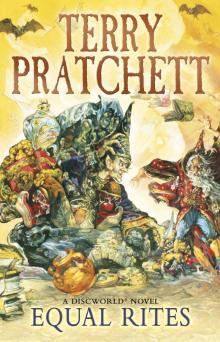 Equal Rites
Equal Rites A Hat Full of Sky
A Hat Full of Sky The Light Fantastic
The Light Fantastic Mrs Bradshaw's Handbook
Mrs Bradshaw's Handbook Wyrd Sisters
Wyrd Sisters Soul Music
Soul Music Small Gods
Small Gods Sourcery
Sourcery Reaper Man
Reaper Man Night Watch
Night Watch Lords and Ladies
Lords and Ladies The Fifth Elephant
The Fifth Elephant Monstrous Regiment
Monstrous Regiment The Truth
The Truth Witches Abroad
Witches Abroad Eric
Eric Going Postal
Going Postal Men at Arms
Men at Arms Jingo
Jingo The Amazing Maurice and His Educated Rodents
The Amazing Maurice and His Educated Rodents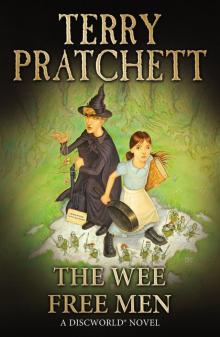 The Wee Free Men
The Wee Free Men Pyramids
Pyramids Wintersmith
Wintersmith Moving Pictures
Moving Pictures Carpe Jugulum
Carpe Jugulum Interesting Times
Interesting Times Maskerade
Maskerade Making Money
Making Money The Shepherd's Crown
The Shepherd's Crown Hogfather
Hogfather Troll Bridge
Troll Bridge The Last Continent
The Last Continent The Sea and Little Fishes
The Sea and Little Fishes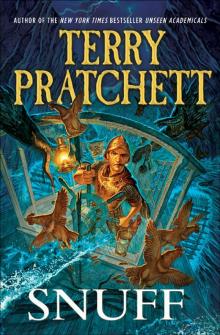 Snuff
Snuff Unseen Academicals
Unseen Academicals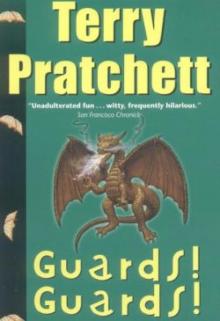 Guards! Guards! tds-8
Guards! Guards! tds-8 Jingo d-21
Jingo d-21 Turtle Recall: The Discworld Companion ... So Far
Turtle Recall: The Discworld Companion ... So Far The Fifth Elephant d-24
The Fifth Elephant d-24 Discworld 39 - Snuff
Discworld 39 - Snuff The Long War
The Long War Only You Can Save Mankind
Only You Can Save Mankind The Science of Discworld III - Darwin's Watch tsod-3
The Science of Discworld III - Darwin's Watch tsod-3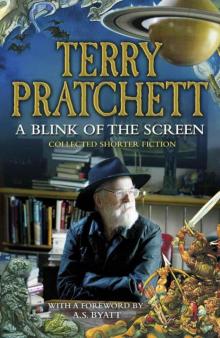 A Blink of the Screen: Collected Short Fiction
A Blink of the Screen: Collected Short Fiction Unseen Academicals d-37
Unseen Academicals d-37 Wings
Wings Making Money d-36
Making Money d-36 A Blink of the Screen
A Blink of the Screen Johnny and the Bomb
Johnny and the Bomb Dodger
Dodger Strata
Strata Discworld 02 - The Light Fantastic
Discworld 02 - The Light Fantastic The Folklore of Discworld
The Folklore of Discworld The Science of Discworld
The Science of Discworld The Unadulterated Cat
The Unadulterated Cat Raising Steam: (Discworld novel 40) (Discworld Novels)
Raising Steam: (Discworld novel 40) (Discworld Novels) The World of Poo
The World of Poo Discworld 05 - Sourcery
Discworld 05 - Sourcery The Witch's Vacuum Cleaner: And Other Stories
The Witch's Vacuum Cleaner: And Other Stories The Science of Discworld II - The Globe tsod-2
The Science of Discworld II - The Globe tsod-2 Small Gods: Discworld Novel, A
Small Gods: Discworld Novel, A Men at Arms tds-15
Men at Arms tds-15 Tama Princes of Mercury
Tama Princes of Mercury The Last Hero (the discworld series)
The Last Hero (the discworld series) The Long Utopia
The Long Utopia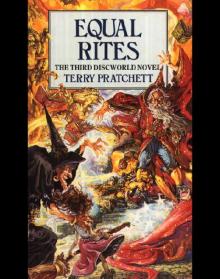 Discworld 03 - Equal Rites
Discworld 03 - Equal Rites Terry Pratchett - The Science of Discworld
Terry Pratchett - The Science of Discworld The Long Earth
The Long Earth The Carpet People
The Carpet People The Sea and Little Fishes (discworld)
The Sea and Little Fishes (discworld)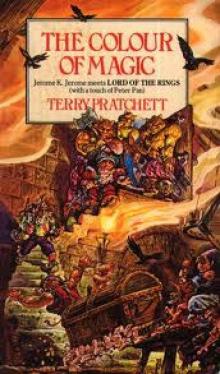 The Colour of Magic
The Colour of Magic Discworld 16 - Soul Music
Discworld 16 - Soul Music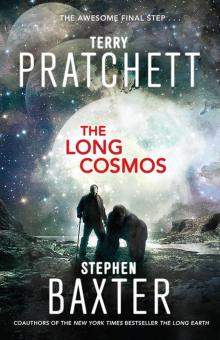 The Long Cosmos
The Long Cosmos The Dark Side of the Sun
The Dark Side of the Sun Monstrous Regiment tds-28
Monstrous Regiment tds-28 The Bromeliad 3 - Wings
The Bromeliad 3 - Wings Dragons at Crumbling Castle: And Other Stories
Dragons at Crumbling Castle: And Other Stories Night Watch tds-27
Night Watch tds-27 The Science of Discworld I tsod-1
The Science of Discworld I tsod-1 The Bromeliad 1 - Truckers
The Bromeliad 1 - Truckers The Science of Discworld Revised Edition
The Science of Discworld Revised Edition The Abominable Snowman
The Abominable Snowman Father Christmas’s Fake Beard
Father Christmas’s Fake Beard The Bromeliad Trilogy
The Bromeliad Trilogy A Slip of the Keyboard
A Slip of the Keyboard The Wee Free Men d(-2
The Wee Free Men d(-2 Johnny and the Dead
Johnny and the Dead Mrs Bradshaw's Handbook (Discworld Novels)
Mrs Bradshaw's Handbook (Discworld Novels) Truckers
Truckers The Amazing Maurice and His Educated Rodents d(-1
The Amazing Maurice and His Educated Rodents d(-1 Diggers
Diggers Thief of Time tds-26
Thief of Time tds-26 Science of Discworld III
Science of Discworld III Dragons at Crumbling Castle
Dragons at Crumbling Castle Nation
Nation Darwin's Watch
Darwin's Watch Interesting Times d-17
Interesting Times d-17 The Bromeliad 2 - Diggers
The Bromeliad 2 - Diggers The Science of Discworld II
The Science of Discworld II